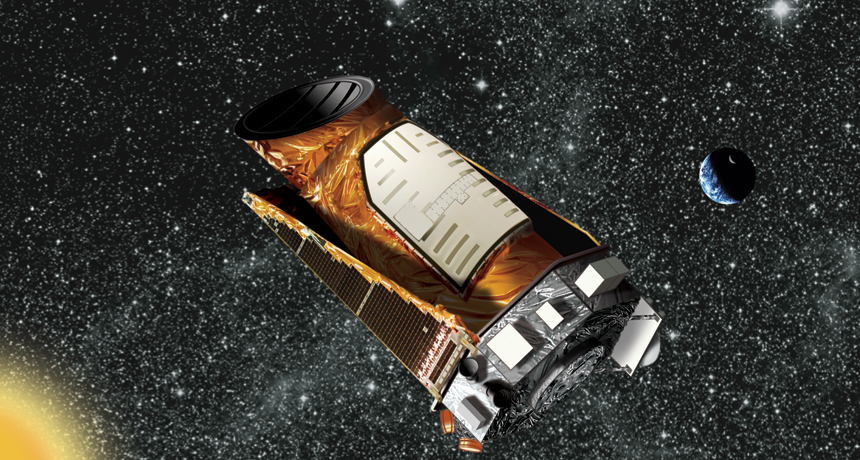So many ‘Earths’
Our galaxy alone may host billions, a new study estimates

Data from the Kepler spacecraft (which is shown in this artist’s picture) indicate the Milky Way may host billions of planets that could sustain Earthlike life.
Wendy Stenzel/NASA
By Andrew Grant
The Milky Way contains billions of Earth-sized planets that could support life. That’s the finding of a new study. It draws on data that came from NASA’s top planet-hunting telescope.
A mechanical failure recently put that Kepler space telescope out of service. Kepler had played a big role in creating a census of planets orbiting some 170,000 stars. Its data have been helping astronomers predict how common planets are in our galaxy. The telescope focused on hunting planets that might have conditions similar to those on Earth.
The authors of a study published November 4 in the Proceedings of the National Academy of Sciences now conclude that between 14 and 30 out of every 100 stars with a mass and temperature similar to the sun may host a planet that could support life as we know it. Such a planet would have a diameter at least as large as Earth’s, but no more than twice that big. The planet also would have to orbit in a star’s habitable zone. That’s where the surface temperature would allow any water to exist as a liquid.
The new estimate of how many planets might fit these conditions comes from studying more than 42,000 stars and identifying suitable worlds orbiting them. The scientists used those numbers to extrapolate to the rest of the stars that the telescope could not see.
The estimate is rough, the authors admit. If applied to the solar system, its would define as habitable a zone starting as close to the sun as Venus and running to as far away as Mars. Neither planet is Earthlike (although either might have been in the distant past). Using tighter limits, the researchers estimate that between 4 and 8 out of every 100 sunlike stars could host an Earth-sized world. These are ones that would take 200 to 400 days to complete a yearly orbit.
Four out of every 100 sunlike stars doesn’t sound like a big number. It would mean, however, that the Milky Way could host more than a billion Earth-sized planets with a chance for life.
Power Words
astronomy The area of science that deals with celestial objects, space and the physical universe as a whole. People who work in this field are called astronomers.
diameter The length of a straight line that runs through the center of a circle or spherical object, starting at the edge on one side and ending at the edge on the far side.
exoplanet A planet that orbits a star outside the solar system.
extrapolate To estimate a number based on some existing data, when those data are aren’t sufficient to be able to calculate a number directly.
galaxy A massive group of stars bound together by gravity. Galaxies, which each typically include between 10 million and 100 trillion stars, also include clouds of gas, dust and the remnants of exploded stars.
habitable A place suitable for humans or other living things to comfortably dwell.
mass A number that shows how much an object resists speeding up and slowing down — basically a measure of how much matter that object is made from.
Milky Way The large spiral galaxy in which Earth’s solar system resides.
orbit The curved path of a celestial object or spacecraft around a star, planet or moon. One complete circuit around a celestial body.
planet A celestrial object that orbits a star, is big enough for gravity to have squashed it into a roundish ball and it must have cleared other objects out of the way in its orbital neighborhood.
star The basic building block from which galaxies are made. Stars develop when gravity compacts clouds of gas. When they become dense enough to sustain nuclear-fusion reactions, stars will emit light and sometimes other forms of electromagnetic radiation. The sun is our closest star.
sun The star at the center of Earth’s solar system. Average in size, our star sits about 26,000 light-years from the center of the Milky Way galaxy.
telescope A light-collecting instrument that makes distant objects appear nearer through the use of lenses or a combination of curved mirrors and lenses. Some, however, collect radio emissions (energy from a different portion of the electromagnetic spectrum) through a network of antennas.







